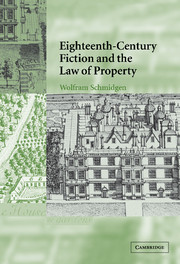Book contents
- Frontmatter
- Contents
- Acknowledgments
- Introduction
- 1 Communal form and the transitional culture of the eighteenth-century novel
- 2 Terra nullius, cannibalism, and the natural law of appropriation in Robinson Crusoe
- 3 Henry Fielding and the common law of plenitude
- 4 Commodity fetishism in heterogeneous spaces
- 5 Ann Radcliffe and the political economy of Gothic space
- 6 Scottish law and Waverley's museum of property
- Conclusion
- Notes
- Bibliography
- Index
6 - Scottish law and Waverley's museum of property
Published online by Cambridge University Press: 22 September 2009
- Frontmatter
- Contents
- Acknowledgments
- Introduction
- 1 Communal form and the transitional culture of the eighteenth-century novel
- 2 Terra nullius, cannibalism, and the natural law of appropriation in Robinson Crusoe
- 3 Henry Fielding and the common law of plenitude
- 4 Commodity fetishism in heterogeneous spaces
- 5 Ann Radcliffe and the political economy of Gothic space
- 6 Scottish law and Waverley's museum of property
- Conclusion
- Notes
- Bibliography
- Index
Summary
Sir Walter Scott once likened the experience of reading Tom Jones – the “first English novel” in his estimation – to a boat ride. The reader, he reflected, “glides down the narrative like a boat on the surface of some broad navigable stream, which only winds enough to gratify the voyager with the varied beauty of its banks.” Scott's first novel, Waverley; or, 'Tis Sixty Years Since (1814), pursues a similarly winding course through historical territory already important in Tom Jones. Its eponymous hero wanders through the confusing political landscape of the 1745 Jacobite rebellion, wavering between England and Scotland, Hanoverians and Jacobites, Lowlands and Highlands, duty and inclination, history and romance. Only at the end of the novel, with a somewhat abrupt shift of political and personal allegiances, does Edward Waverley arrest his ambulatory course. He distances himself from the rebellion and the Highlands and marries Rose Bradwardine, daughter of the Lowland Jacobite Baron Bradwardine. Echoing Fielding's ending, Scott's denouement restores all the property that was lost in the scuffle of the rebellion and unites Jacobite and Whig estates.
But while Scott's ending celebrates the return of lost property to its original owners, Waverley is not a comedy of things, and this is – at least in part – because it is not an English but a Scottish novel. The comic overtones of Waverley's final scene, when Baron Bradwardine reclaims his temporarily forfeited estate, mask a serious engagement with the irremediable changes wrought by the last Jacobite rebellion.
- Type
- Chapter
- Information
- Eighteenth-Century Fiction and the Law of Property , pp. 186 - 213Publisher: Cambridge University PressPrint publication year: 2002

